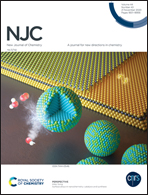A potential naphthyl-thiazole-based organic dye and a ditopic chromogenic probe for CN− and Fe3+ with molecular logic functions†
Abstract
Dye sensitizers are entities designed primarily to serve the function of harvesting light photons in the functional wavelength, which is centered on charge transfer mechanisms. A metal-free dye sensitizer (J) based on the naphthyl-thiazole groups was synthesized via a one-step reaction mechanism and characterized using UV-vis, 1H NMR and fluorescence spectroscopic methods. The applications of J were investigated based on its charge transfer mechanisms of photoinduced electron transfer (PET) and excited-state intermolecular proton transfer (ESIPT) mechanisms. Subsequently, J displayed several charge transfer-based properties complementary to dye sensitizers, chemosensing and molecular logic functions. The properties were investigated and studied primarily in acetonitrile (CH3CN), as a polar solvent of choice. The optical properties of J were investigated through solvatochromism, aided by theoretical recreation, while chemosensing properties were investigated, thereby in the process establishing that J is a ditopic probe which could selectively discriminate CN−, F− and AcO− as well as Fe3+ in CH3CN, among other ions. In addition, the reversibility and reproducibility studies substantiated that J exhibits molecular logic operation properties, based on complementary IMP/INH logic functions. Thus, J can be utilized as a colorimetric molecular switch modulated by CN−/Hg2+.



 Please wait while we load your content...
Please wait while we load your content...